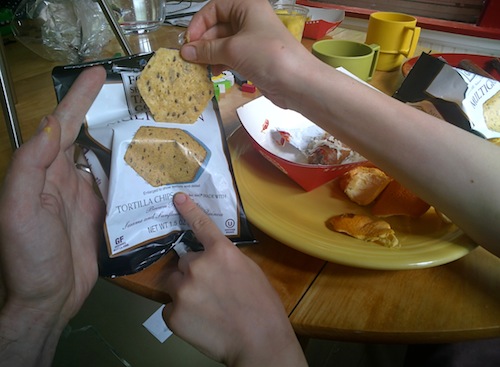I told an abbreviated version of the following story on my math-teacher blog, where I used it to drive home a point to my colleagues. This version is for parents.
—
My wife had been out of town for several days. I was tired of doing all the cooking and dishes. It was a lovely Saturday evening at the end of a busy day.
It was time for nutrition lessons.
It was time to get dinner at Holiday.
Oh right, like you have never done this.
The constraint was this: The kids had to select something from each of the four major food groups (do not try to talk to me about that new food pyramid; I will not listen.) They needed a meat/protein, a fruit/vegetable, a dairy and a grain.
Griffin (9 years old): Do donuts count as a grain? They have a lot of flour in them.
Me: Scratch that. WHOLE grain. No. Donuts do not count as a grain.
It turns out that the whole grains are hardest to find.
At Holiday, you’re not going to do much better than tortilla chips, whole-grain wise.
As a mathy bonus, Griffin later noticed that the claim underneath the picture of the chip on the bag reads, Enlarged to show texture and detail, but that the image is the same size as the chip.
But back to our story.
Tabitha (7 years old) had brought along money to buy some hot Cheetos.
She was under the impression that they would cost $1.35, and she had her money ready. Five quarters, one dime. She even had me check that these coins totaled $1.35.
When she got to the front of the line, it turned out that they Cheetos cost $1.49.
It would have been fun to talk about the difference in price here, and have her fish out the right amount to make up the difference. But there were people in line behind us. We needed to move this along.
I told her to get two more dimes out of her coin purse and give them to the man. I intercepted the change so as not to give away the answer to the question I was about to ask, and we turned to leave.
Me: You owed him 14 more cents and gave him 20. How much change should you have gotten back?
Tabitha seemed confused by my question. It was not that she was unable to answer it; rather she did not understand the whole getting change thing. I made a mental note of this and pressed on.
Me: You gave him 20 cents when you only owed him 14 cents. So you get some money back. How much should that be?
Still nothing. It seemed the money/change/debt thing was getting in the way of thinking through this number relationship. So I switched tactics.
By this time, we are outside, strolling slowly home.
Me: How much more is 20 than 14?
This question put her in a different frame of mind. She slowed down and looked dreamily into space. She was thinking.
Tabitha (7 years old): Thirty-four? or maybe thirty-five?
Ugh. Right answer, wrong relationship. I think she cued in on the more in that sentence.
I tried one last time to trigger the thinking I know she can do.
Me: Let’s try this. Fourteen plus something is 20. What is the something?
There was a long, thoughtful pause.
Griffin interrupted the pause.
Griffin (9 years old): How old were you last year?
T: Six!
Me: Did you work that out, or did you say it because Griffy said it?
T: Griffy.
Griffin and I had talked about this before. But we talked about it again on the way home—about how it is important for Tabitha to have the opportunity to think things through for herself. I tried to anticipate his needs: (1) to demonstrate that he knows, and (2) to help his sister.
If he needs to demonstrate that he knows, he can:
- Say he knows but keep the answer to himself,
- Write it down,
- Ask if he can whisper it in my ear.
If he honestly wants to help his sister, he can ask a question that will help her think. How old were you last year? does not help her to think about the relationship between 14 and 20. But How much more is twenty than fifteen? might help her think, because she has often counted by fives.
So what do we learn?
We learn that it is sometimes quite difficult to get the right question that will get a child to think. Context, time pressures, level of difficulty, mood, the presence of siblings…all of these things can conspire to cut off the thinking.
But if you are persistent in the moment, you may get somewhere.
And if you are doing this every day, you’ll eventually hit the sweet spot.
Most of all, we learn that it is the thinking that matters, not getting the kid to say the right answer.
Starting the conversation
Persistence is key. I didn’t get where I wanted in this conversation. You won’t get there sometimes either. That’s OK.
Ask your question, adjust it if necessary. Let it go if you need to.
There’s always another day.


